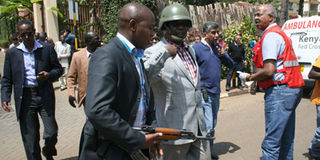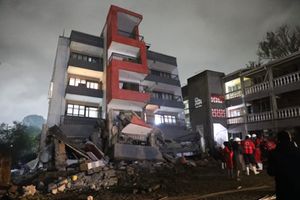Why scenes from Westgate have shamed us internationally

Inspector General of Police David Kimaiyo at Westgate Mall on September 21, 2013. PHOTO | WILLIAM OERI |
What you need to know:
- As the gruesome details of the massacre at the Westlands Mall in Nairobi a year ago were brought back to life by British film maker, Dan Reed, I also wondered whether President Kenyatta’s lieutenants were watching.
- Camera footage shows both the police and KDF soldiers leave the mall 90 minutes later as the terrorists continue to cause mayhem. A shopper says that victims who had fled to Westgate's rooftop lay bleeding as they waited for help to arrive, which never did.
Even a kindergartener would shake his or her head in disapproval after sitting through the hour long film aptly titled ‘Terror at the Mall.’
And the displeasure would not be with the way the documentary was made – or the heroic action by many civilians and a few off duty police officers - but with how the government responded to the ensuing melee.
As I watched the documentary in Atlanta on the day it premiered on HBO, I kept wondering whether President Uhuru Kenyatta was viewing the same or whether he had watched the raw footage long before it was made into a documentary. If so, what was going through his mind when the film was released for public broadcast?
As the gruesome details of the massacre at the Westlands Mall in Nairobi a year ago were brought back to life by British film maker, Dan Reed, I also wondered whether President Kenyatta’s lieutenants were watching. “Did he watch - probably together with CS Joseph Ole Lenku - from a remote location in Hurlinghum where we have since come to learn was a convergence with feeds from all the security cameras at Westgate?” I wondered.
NO PLAN
In the movie which features never seen before footage of the horror, it is crystal clear that both the police and KDF score poorly. The commentator describes the Kenyan soldiers and members of the police SWAT team as “confused and lacking a comprehensive plan.”
These forces did not arrive on the scene for almost an hour after the attack began and did not enter the mall for another two hours, the documentary shows. When they finally got into the mall, they mistakenly fired at one another, leaving one police officer dead and others injured, narrates Reed.
Camera footage shows both the police and KDF soldiers leave the mall 90 minutes later as the terrorists continue to cause mayhem. A shopper says that victims who had fled to Westgate's rooftop lay bleeding as they waited for help to arrive, which never did.
“We lay there for a very long time,” Jasmine Postwalla, who was trapped on the upper level, says in an interview. “You would expect to see a lot of armed soldiers and all coming up the ramp. Maybe that was what we were expecting, but that didn't happen.”
When it was over, I felt sad. Very sad. There were glaring inconsistencies with what for a whole year, the Kenyan public – and indeed the world – had been made to believe by the government. I have been shaking my head since.
“Now that it is uncensored public information, would the government alter the statements made a year ago during and after the siege just to set the record straight?” I asked myself.
MANY ASKING QUESTIONS
It turned out that I was not the only one asking these questions. Neither was it the first time that Kenyans were shocked by the bungled operation. BBC, New York Times, CNN and other leading international media houses have been giving the film prominence in their reports. Many who have watched the film have reacted with astonishment at the way the government and its security apparatus handled the situation. And the debate has been on for a while.
In November last year, Kenyan journalist Murithi Mutiga wrote the following in an OP/ED in the Observer, a British Newspaper:
“The drawn-out nature of the siege at the mall and the casual cruelty of the attackers, who murdered pregnant women and children attending, of all touchingly innocent things, a cooking competition under the blue Nairobi sky, shocked people around the world. But Kenyans struggling to recover from the horror must also take in the shocking revelations of official bungling on an epic, even criminal scale that characterised the response to the attack.”
Since the attack, I have watched many televised interviews on the subject matter. One that caught my attention was aired by Citizen TV on April 8, 2014. In it, the president said despite promising Kenyans an inquiry into the attack, he had let parliament do it since “it would be a waste of resources to have two parallel investigations.” Asked what would be the next course of action since the legislature had rejected the report, the president said; “I have to engage with them and ask them, what next.” That was the last Kenyans heard about the enquiry.
TOO DAMNING TRUTH?
Now the film is raising more questions than answers. But the greatest question that many – including some leaders in the Jubilee coalition albeit in hushed tones – is why the government found it necessary to be economical with the truth. Could it be that the truth in its entirety could have been too damning?
Granted, anyone can be misled into issuing an erroneous statement based on wrong information. But I find it disturbingly insincere for government officials – including the president – to remain quiet even when questions scream for answers.
In civilised societies, leaders and government officials take responsibility and recant such statements – and even apologise to the people because it is the right thing to do. Some even resign while others are dismissed or asked to step down over gross ineptitude.
Why is it that no one has not found it prudent to come out and apologise to Kenyans for the action, or lack thereof, which cost more lives than it should have? Could it be that the president thinks that apologising to Kenyans, or even relieving some officials of their duties, would be construed as a weakness of sorts?
But even as those questions bothered me as I watched the Westgate Mall events in their raw form, I was greatly encouraged by the resilience and courage of many of the survivors as they narrated their experience in the hands of the ruthless Al Shabaab terrorists. One of them even saw a silver lining in the horrific incident.
“We don’t know each other,” said Valentine Kadzo, who hid for hours with others in a tiny display area. “We all come from different communities, but at that time we were one. I’ll always treasure that moment because everyone was caring about the other.”





